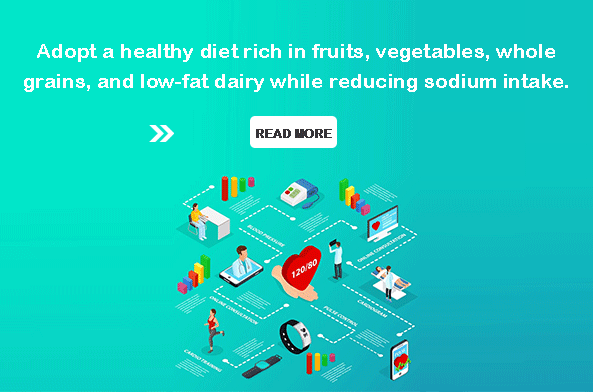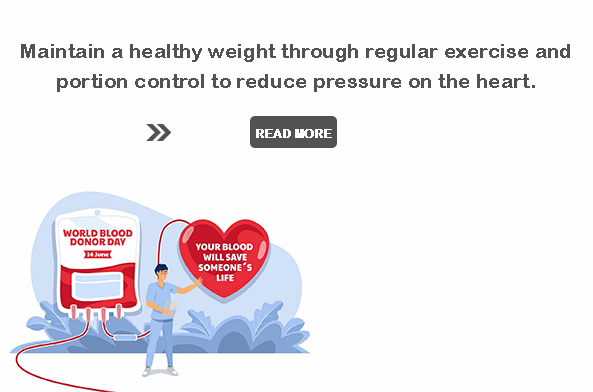If you have been diagnosed with hypertension, you may be concerned about using medication to lower your blood pressure levels.
The way you live affects how well your high blood pressure is managed. By leading a healthy lifestyle and effectively controlling your blood pressure, you may be able to prevent, postpone, or minimize the need for medication.
These ten lifestyle modifications can help you maintain and reduce your blood pressure.

1. Reduce additional weight and keep an eye on your waistline
Weight gain is commonly associated with elevated blood pressure. Additionally, being overweight can lead to sleep apnea, which is a disorder of breathing during sleep that elevates blood pressure even more.
One of the best lifestyle modifications for blood pressure regulation is losing weight. Even a small weight loss can help reduce blood pressure if you are fat or overweight.
For every kilogram (approximately 2.2 pounds) of weight lost, your blood pressure may generally drop by 1 millimeter of mercury (mm Hg).
In addition to losing weight, you usually need to pay attention to your waist size. Your risk of high blood pressure may increase if you carry excess weight around your waist.
Generally speaking, males who have a waist measurement more than 40 inches (102 cm) are at risk.
If a woman’s waist measures more than 35 inches (89 cm), she may be at risk.
These numbers vary among ethnic groups.Find out from your doctor what constitutes a healthy waist size for you.
2. Get frequent exercise
If you have high blood pressure, engaging in 150 minutes of physical activity per week, or roughly 30 minutes most days of the week, can help lower it by 5 to 8 mm Hg.
Maintaining consistency is crucial because stopping an exercise regimen can cause your blood pressure to spike once more
Exercise can help prevent hypertension if your blood pressure is already high.
Engaging in regular physical activity can help lower blood pressure to safer levels if you already have hypertension.
To reduce your blood pressure, you could attempt aerobic activities like cycling, swimming, dancing, walking, or jogging.
Another option is high-intensity interval training, which alternates between brief bursts of high-intensity exercise and later recovery intervals of lower-intensity exercise.
Additionally, strength exercise helps lower blood pressure. Try to incorporate strength training into your workouts at least twice a week. Consult your physician about creating an exercise regimen.
3. Consume a balanced diet
If you have high blood pressure, eating a diet low in saturated fat and cholesterol and high in whole grains, fruits, vegetables, and low-fat dairy products can reduce your blood pressure by as much as 11 mm Hg. The Dietary Approaches to Stop Hypertension (DASH) diet is the name of this eating regimen.
Although it is difficult to alter your eating habits, you can adopt a healthy diet by following these tips:
Have a food journal. Even for a week, journaling your meals might reveal a lot about your actual eating patterns. Keep an eye on what, when, how much, and why you eat.
Think about increasing potassium. Potassium can decrease the blood pressure-raising effects of salt. Supplements are not the best source of potassium; eating, including fruits and vegetables, is. Consult your physician about the ideal potassium level for you.
Be a savvy consumer. When shopping, read the labels on food products, and when dining out, follow your healthy eating plan as well.
4. Cut back on sodium in your meals
If you have high blood pressure, even a modest decrease in salt in your diet can help your heart and lower it by roughly 5 to 6 mm Hg.
The impact of salt consumption on blood pressure differs amongst demographic groups.In general, limit your daily sodium consumption to 2,300 mg or less. However, it is advised that adults consume no more than 1,500 mg of salt per day.
To reduce the amount of sodium in your diet, try these suggestions:
Check the food labels. Select low-sodium versions of the foods and drinks you typically purchase, if at all possible.
Consume less processed food. Foods only contain trace amounts of sodium by nature. Processing adds the majority of the sodium.
Avoid adding salt. The sodium content of just one level teaspoon of salt is 2,300 mg. To give your cuisine more taste, use herbs or spices.
Take it easy. Reduce your intake of salt gradually if you don’t think you can do so quickly. With time, your palate will change.
5. Cut back on the amount of alcohol you consume.
Alcohol has both positive and negative health effects. One drink per day for women and two for men is the recommended amount of alcohol to consume in moderation. This can potentially reduce blood pressure by approximately 4 mm Hg. Twelve ounces of beer, five ounces of wine, or 1.5 ounces of 80-proof liquor make up one drink.
Nevertheless, excessive alcohol consumption counteracts this protective effect.
In fact, excessive alcohol use can cause blood pressure to rise several points. Additionally, it may lessen the benefits of blood pressure drugs.
6. Give up smoking
Your blood pressure rises with each cigarette you smoke and stays elevated for several minutes following. Giving up smoking aids in the normalization of your blood pressure.
Giving up smoking can enhance your general health and lower your chance of heart disease. It’s possible that smokers who give up live longer than those who never do.
7. Reducing caffeine intake
Caffeine’s effect on blood pressure is still up for dispute. In those who do not often use it, caffeine can increase blood pressure by up to 10 mm Hg. However, frequent coffee drinkers might not notice a difference in their blood pressure at all.
Caffeine may cause a modest elevation in blood pressure, while the long-term effects on blood pressure are unknown.
Measure your blood pressure 30 minutes after consuming a caffeinated beverage to see whether caffeine causes an increase in blood pressure.
You can be susceptible to the effects of coffee on blood pressure elevation if your blood pressure rises by 5 to 10 mm Hg. Discuss the impact of coffee on your blood pressure with your physician.
8. Lessen your anxiety
High blood pressure may be a result of ongoing stress. The consequences of long-term stress on blood pressure require further study. Periodic stress can also raise blood pressure if it is met with unhealthy food, alcohol, or tobacco use as a coping mechanism.
Consider for a moment what stresses you out, whether it be work, family, money, or health issues. After you’ve identified the source of your stress, think about ways to lessen or eliminate it.
Even if you are unable to completely remove all of your stressors, you can learn healthy coping mechanisms. Aim to:
Modify your expectations. Plan your day and prioritize your tasks, for instance.
Refrain from overcommitting and develop your ability to say no. Recognize that while there are some things you cannot control or alter, you can choose how you respond to them.
Develop solutions for the issues you can control and focus on them.Speak with your manager if you’re having problems at work. Take action to resolve any conflicts you may be experiencing with your spouse or children.
Steer clear of stressors. Avoid triggers as much as you can. For instance, try leaving earlier in the morning or using public transit if you find that rush-hour traffic on your way to work stresses you out.
If at all possible, stay away from stressful people
Schedule downtime for enjoyable activities and relaxation.Make time each day to sit still and take deep breaths. Schedule time for hobbies or pleasurable pursuits like cooking, volunteering, or going for a walk.Embrace thankfulness. Giving thanks to others can assist in lowering your stress levels.
9. Keep an eye on your blood pressure at home and visit your physician frequently.
Keeping an eye on your blood pressure, confirming that your lifestyle modifications are effective, and notifying you and your physician of any possible health issues are all made possible with home monitoring. There are many blood pressure monitors accessible without a prescription. Before you begin, discuss home monitoring with your physician.
Another essential component of blood pressure regulation is routine medical visits. Consult your doctor to determine how frequently you should get your blood pressure checked if it is under control.
Your physician could advise checking it every day or less frequently. Your doctor might advise you to monitor your blood pressure beginning two weeks following treatment modifications and one week prior to your next appointment if you’re making any adjustments to your drugs or other therapies.
10. Obtain help
Your health might be enhanced by friends and family who are supportive. To help you maintain low blood pressure, they might drive you to the doctor, urge you to take care of yourself, or join you in an exercise regimen.
Consider joining a support group if you discover that you require assistance from sources other than your friends and family. This could connect you with others who can support you emotionally or morally and provide helpful advice on managing your disease.


